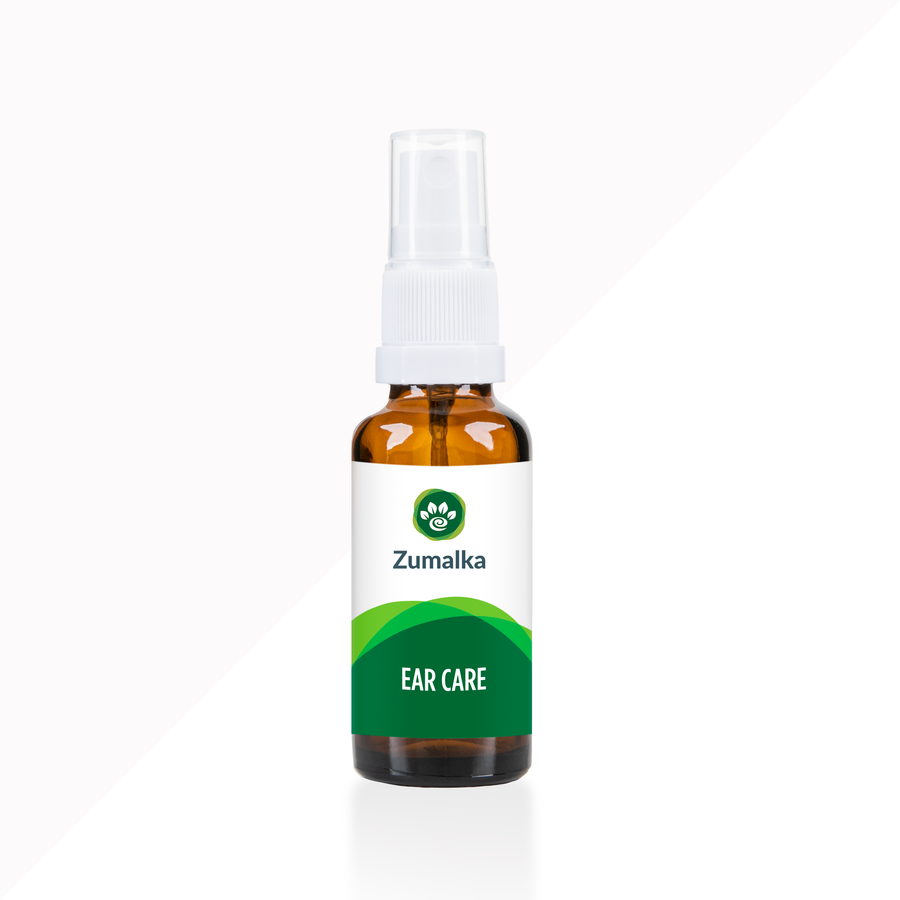Vet-Recommended: 7 Natural Remedies for Cat Ear Infections (Plus Prevention Tips)

Is your cat constantly scratching its ears or shaking its head in discomfort? These common signs could point to a cat ear infection, an often overlooked but treatable condition with the right care.
Cat ear infections are surprisingly common and can affect felines of any age or breed. Beyond pain and discomfort, they can impair your cat’s hearing, balance, and overall well-being.
Timely care is crucial, as untreated ear infections can progress and cause long-term problems for your cat. Before using any home remedies, consult a veterinarian or qualified pet homeopathy specialist, especially if there's bleeding, discharge, or obvious pain.
Home remedies are best suited for mild ear infections or as supportive care following a diagnosis from a veterinarian or a consultation with a pet homeopathy expert. They should never replace professional guidance, especially in more serious cases.
Cat Ear Infections Explained: Causes, Signs, and What to Watch For
A cat ear infection is an inflammation of the outer, middle, or inner ear, commonly referred to as otitis externa or otitis media. These infections often develop when the natural balance of the ear canal is disrupted by moisture, debris, or harmful microorganisms.
Many cat ear infections stem from underlying issues such as allergies, mites, or skin disorders. Treating these root causes is essential for lasting relief and preventing future infections.
Top causes of ear infections in cats
- Ear mites are the most common cause of cat ear infections, accounting for over half of all cases. Highly contagious, they trigger intense itching and produce a black, waxy discharge that resembles coffee grounds.
- Allergies to food, pollen, or environmental triggers can lead to ear inflammation and excessive wax buildup in cats. This irritation often creates the perfect environment for ear infections to develop.
- Disruptions in the ear canal can cause yeast or bacteria to multiply excessively, leading to infection. These overgrowths often result in inflammation, foul odor, and discharge.
- Irritants like grass seeds or dirt can get stuck in a cat’s ear canal, triggering inflammation and infection. Likewise, a buildup of earwax can trap bacteria or yeast, increasing the risk of infection.
- Underlying health conditions like diabetes, autoimmune diseases (such as FIV or FeLV), or a weakened immune system can make cats more vulnerable to ear infections. These issues reduce the body’s ability to fight off bacteria, yeast, and other irritants in the ear.
- Moisture from bathing, swimming, or other cats licking the ears can accumulate in the ear canal, creating a warm, damp environment. This excess moisture encourages the growth of bacteria and yeast, increasing the risk of infection.
- Other contributing factors include ear polyps, ruptured eardrums, trauma, overgrown ear hair, and improper cleaning techniques. Even stress or a biologically inappropriate diet, like high-carb kibble, can lead to inflammation and gut imbalances that may trigger ear infections.
Symptoms of cat ear infections and what to watch for
- Common behavioral signs of a cat ear infection include frequent pawing, scratching, head shaking, or tilting. You may also notice visible symptoms such as redness, swelling, or irritation around the ear canal or flap.
- Ear infections in cats often produce unusual discharge, yellow, black, or coffee-ground-like, which may indicate the presence of mites. A strong, foul odor coming from the ear is another common sign of infection.
- Excessive wax buildup in or around the ear canal is a common symptom of ear infections in cats. More serious cases, especially those affecting the inner ear, can lead to hearing loss, disorientation, or problems with balance and coordination.
- A healthy cat’s ears should appear pale pink, free of odor, and have little to no visible debris or wax. Recognizing this normal baseline makes it easier to spot early signs of infection or irritation.
Important precautions before using home remedies for cat ear infections
Consulting a veterinarian or qualified pet homeopathy specialist is essential for an accurate diagnosis of cat ear infections. Using tools like an otoscope and microscopic analysis, they can identify the exact cause, whether mites, bacteria, yeast, or an underlying condition, ensuring the right treatment is given.
A holistic veterinary consultation can also assess the severity of the infection, including whether the eardrum is ruptured. This evaluation is critical, as severe infections may require medical intervention and specific treatments that home remedies cannot safely address.
Some cat ear infections require prescription-strength antibiotics, antifungals, or anti-parasitic medications that only a veterinarian can provide. Gentle and effective, homeopathic remedies offer natural support and relief, especially in the early stages of infection. Without proper treatment, the infection may worsen or become resistant to over-the-counter remedies.
Treating cat ear infections correctly from the start helps prevent long-term complications. If left untreated or managed improperly, these infections can progress to chronic conditions, hearing loss, or even facial nerve damage.
What NOT to do when treating cat ear infections at home
Never insert solid objects like Q-tips into your cat’s ear canal unless specifically directed by a veterinarian. Doing so can push debris deeper, cause injury, or even rupture the eardrum, worsening the infection.
Not all cleaning solutions are safe for cats. Hydrogen peroxide and certain vinegar mixtures can cause irritation or discomfort if used improperly. Always consult a vet or a qualified pet homeopath, and if using home remedies, be sure to dilute them thoroughly and apply with caution.
Never use human medications to treat cat ear infections, as many can be harmful or even toxic to pets. Always rely on treatments prescribed by your veterinarian or natural and homeopathic products specifically formulated for feline use.
7 Vet-Approved Home Remedies for Cat Ear Infections (With Guidance from a Pet Homeopathy Expert)

While these home remedies can support symptom relief and ear cleaning, they are not a replacement for a proper veterinary diagnosis. Always work with a veterinarian or a qualified pet homeopath to identify and treat the underlying cause of your cat’s ear infection.
#1. Olive oil
Olive oil can help gently clean your cat’s ears by softening wax and suffocating ear mites. With veterinary or homeopathic guidance, apply 1-2 drops into the ear to assist in removing debris. Avoid using this approach if your cat has an ear infection or a ruptured eardrum, and consult your veterinarian first.
To help loosen and draw out debris, massage the base of your cat's ear upward. Use a fresh, gentle cloth or gauze to remove any discharge that is visible, but do not put anything within the ear canal.
#2. Diluted apple cider vinegar (ACV) solution
Diluted apple cider vinegar (ACV) has natural antibacterial and antifungal properties that may help fight yeast and bacterial infections in your cat’s ears. When used correctly under professional guidance, it can support gentle cleaning and restore a healthy ear environment.
Apple cider vinegar (ACV) is not recommended for cats with skin lesions, open wounds, or severe inflammation. Using it in these cases may cause irritation or discomfort, so always consult your veterinarian before applying.
To make a safe, diluted solution, mix equal parts water and apple cider vinegar. Never put it in the ear canal directly. Avoid letting any solution drip into your cat’s ear canal, as it can sting or worsen an existing infection. For ear mites, veterinary treatments are the most effective. Natural options like diluted solutions should be used only to gently clean the outer ear (pinna).
Apply the diluted solution once or twice daily until symptoms improve, unless otherwise advised by your veterinarian or a qualified pet homeopath. Because vinegar can irritate if not properly diluted, use with caution and discontinue if your cat shows signs of discomfort.
#3. Yellow dock root (Rumex crispus) extract solution
Yellow dock root extract is known for its natural anti-inflammatory properties, making it helpful for soothing painful ear infections in cats. To apply, dilute 5 drops of the extract in 1 tablespoon of water before use.
Quick note: Yellow dock root should never be used inside the ear canal, as it may irritate sensitive mucosal tissue. Reserve it for external use only, and consult your veterinarian or pet homeopathy expert before applying.
Apply a cotton swab to the outer ear and ear tip after gently soaking it in the diluted yellow dock solution. To avoid irritation or damage, do not place the swab inside the ear canal.
#4. Coconut oil
Coconut oil offers natural antimicrobial and anti-inflammatory benefits that can help ease pain, reduce swelling, and support gentle ear cleaning. When used correctly with veterinary or pet homeopathic guidance, it may also aid in controlling ear mites.
After placing a few drops of coconut oil into your cat’s ear, gently massage the base to help it spread evenly. Alternatively, soak a cotton ball in the oil and hold it against the ear, allowing the oil to gradually absorb.
Gently massage upward from the base of your cat’s ear to help loosen debris or dislodge foreign particles. This technique can be repeated once or twice daily, as recommended by your veterinarian or pet homeopathy expert.
#5. CBD (Cannabidiol) products
CBD (cannabidiol) products may help relieve itchiness, inflammation, and discomfort associated with cat ear infections. While not a direct treatment for mites or infection, CBD can provide supportive relief when used under veterinary guidance.
CBD options for cats include oils, edible treats, and calming chews designed to support comfort and relaxation. Always consult your veterinarian and follow product instructions to ensure safe and appropriate use.
#6. DIY green tea-based ear cleaning/treatment solution
Green tea is naturally anti-inflammatory and can help calm irritation in a cat’s ear. When used with other gentle ingredients, it may support healing and assist in gently cleaning the ear.
Combine two cups of cooled green tea, two tablespoons of organic apple cider vinegar (with the mother), and five drops of calendula tincture to make a mild, natural ear rinse. As instructed by your veterinarian, carefully inject the solution into your cat's vertical ear canal using a 1–3 ml syringe.
Massage the base of your cat’s ear gently until you hear a squishing sound, indicating the solution is working through the ear canal. Let your cat shake its head, then carefully wipe away any loosened debris with a soft cloth or cotton ball until the ear is clean.
#7. EAR CARE - ADVANCED KIT
There are high-quality natural remedies available to help support your cat’s ear health and provide relief from discomfort. These premium options can complement a holistic approach to wellness and healing.
Zumalka's EAR CARE – ADVANCED KIT includes premium, all-natural products formulated to maintain your cat’s ear health and hygiene. Each ingredient is carefully selected to also support your cat’s overall immune system and well-being.
The EAR CARE - ADVANCED KIT is easy to use and completely free from harsh chemicals, making it a safe choice for your cat. This gentle, oral formula is added to water for easy administration and works from the inside out to help reduce the risk of irritation or side effects, both short- and long-term.
Home Treatment for Cat Ear Infections: Step-by-Step Instructions
- Before starting, gather everything you need: ear cleaner or medication, cotton balls, a towel or blanket for gentle restraint, and some treats for positive reinforcement. Having supplies ready ensures a smoother, stress-free experience for both you and your cat.
- Select a quiet, comfortable space to help your cat feel secure during ear treatment. Use gentle handling and treats to create positive associations and make the process less stressful over time.
- If needed, gently wrap your cat in a towel or blanket to prevent sudden movement, leaving only the head exposed. Before applying any treatment, confirm with your veterinarian which ear, or both, requires care.
- Before applying any medication, clean your cat’s ear thoroughly, unless your veterinarian advises otherwise. Proper cleaning helps remove debris and wax, allowing the medication to work more effectively.
- Gently lift your cat’s ear and apply the prescribed amount of solution or ointment into the ear canal, taking care not to let the nozzle touch the ear. This helps prevent contamination and ensures accurate, hygienic application.
- After applying the medication, gently massage the base of your cat’s ear in a circular motion. This helps distribute the solution evenly throughout the ear canal for better absorption and effectiveness.
- To aid in the removal of any loose material, let your cat shake its head after applying the therapy. To avoid irritation or harm, gently clean the outer ear with a cotton ball, being cautious not to put anything within the ear canal.
- Make sure you wash your hands or change gloves between treating each ear to prevent spreading infection. Maintaining proper hygiene is essential for effective and safe at-home ear care.
- Moreover, always reward your cat with a treat after each ear cleaning or treatment session to build a positive association. This simple step helps reduce stress and makes future care easier for both of you.
Prevention Tips for Cat Ear Infection
Contrary to common belief, preventing cat ear infections is both simple and practical with the right routine. In this section, you'll learn key tips to help keep your cat’s ears healthy and infection-free:
Make routine ear checks a part of your cat’s regular care.
Check your cat’s ears daily for any signs of redness, discharge, foul odor, or excessive wax buildup. Regular visual inspections help catch potential ear infections early, making treatment easier and more effective.
Know what healthy cat ears look like.
A healthy cat’s ears should appear pale pink with no strong odor, visible debris, or excess wax. Recognizing these normal signs helps you quickly identify any changes that may indicate an ear infection.
Early detection of cat ear infections is crucial.
Routine ear checks help you catch signs of infection early, before they become more serious or harder to treat. Early detection allows for quicker intervention and better outcomes for your cat’s health.
Ask for guidance from vets and pet homeopathy experts.
Consult your veterinarian or a pet homeopathy expert for guidance on safely cleaning your cat’s ears. A professional demonstration, or in some cases, a vet-performed cleaning, can help ensure the process is effective and stress-free.
Focus on external ear cleaning.
Unless directed by your veterinarian or pet homeopathy expert, never insert Q-tips or any cleaning tools into your cat’s ear canal. Focus only on gently cleaning the visible outer ear to avoid injury and irritation.
Prevent moisture buildup in your cat’s ears.
Excess moisture in your cat’s ear canal, especially after bathing, can create an ideal environment for infections. Always dry the ears gently and thoroughly to help prevent bacterial or yeast overgrowth.
Nutritional support is important for preventing ear infections.
Feeding your cat a species-appropriate diet, rich in animal protein and free from unnecessary carbohydrates, supports gut health and reduces systemic inflammation. A balanced, carnivore-appropriate diet can play a key role in maintaining healthy ears and preventing infections.
Manage allergies to prevent cat ear infections.
Collaborate with your veterinarian to identify and manage allergies, such as food or environmental triggers, that may contribute to recurring ear infections. An elimination diet is often effective in pinpointing food sensitivities and reducing inflammation.
Minimize stress to prevent ear infections in cats.
Chronic stress in cats can lead to inflammation and leaky gut syndrome, which may weaken the immune system and affect ear health. Reducing stress supports overall wellness and can help prevent recurring ear infections.
Prioritize routine vet visits and pet homeopathy support.
Regular veterinary check-ups help monitor your cat’s overall health and catch potential ear issues early. Consulting a qualified pet homeopath can also offer additional support for maintaining long-term ear and immune health.
Maintain a clean living space to support ear health.
Regularly cleaning your cat’s bedding, toys, and common resting areas helps reduce allergens, bacteria, and mites that can contribute to ear infections. A clean environment supports overall health and minimizes the risk of recurring issues.
Cat Ear Infections: When to See a Vet Right Away

- If your cat’s symptoms worsen, new issues develop, or home remedies show no improvement, seek veterinary care immediately. Delaying treatment can lead to more serious complications and prolonged discomfort.
- Additionally, if your cat becomes more resistant to treatment or shows signs of pain, like vocalizing, flinching, or a red, swollen ear, seek veterinary attention promptly. These symptoms may signal a worsening infection or a more serious underlying issue.
- Red discharge or the appearance of red and white blisters in your cat’s ear or ear canal are warning signs of a potentially serious infection. These symptoms require immediate veterinary evaluation to prevent further complications.
- A strong, worsening odor or buildup of debris in your cat’s ear, despite regular cleaning, may indicate a deep or resistant infection. If these signs persist, consult your veterinarian for a proper diagnosis and treatment plan.
- If your cat stops eating, becomes unusually tired, vomits, has diarrhea, or shows other physical changes, contact your veterinarian right away. These systemic signs could point to a more serious health issue beyond an ear infection.
- If your cat develops a sudden or ongoing head tilt, it could be a sign of a more serious inner ear issue and should be evaluated by a veterinarian. Should your cat show signs of an allergic reaction, such as swelling or a fever, stop treatment immediately and contact your vet.
- Follow-up veterinary exams are essential, even if symptoms appear to have resolved, as infections can persist deep within the ear canal. Avoid cleaning or applying any medication for at least 24 hours before a recheck to ensure an accurate evaluation.
Key Takeaways
Maintaining your cat’s ear health means understanding the common causes and symptoms of ear infections and addressing them through prevention, proper care, and professional guidance. A well-rounded approach, including routine checks, natural remedies, and veterinary support, can keep your cat comfortable, healthy, and infection-free.
While cat ear infections can be frustrating, they’re often manageable with the right knowledge and proactive care. By working closely with your veterinarian and pet homeopathy specialist and maintaining a consistent ear care routine, you can help keep your cat’s ears healthy and infection-free.
Prioritizing your cat’s ear health through regular checks, gentle care, and timely veterinary and pet homeopath guidance can prevent infections before they start. Take proactive steps today to ensure your cat stays comfortable, healthy, and happy.
FAQs
What is the strongest natural antibiotic for cats?
Oregano oil, well-known for its potent antibacterial and antifungal properties, is frequently considered a potent natural antibiotic for cats. Always use it under the supervision of a veterinarian or pet homeopath, and make sure it is safely diluted. SILVERPET offers dual-action support with both topical and oral use, making it an excellent choice for comprehensive care.
What is a homemade ear solution for cats?
A homemade cat ear cleaner can be made by mixing equal parts distilled water and apple cider vinegar. Consult your veterinarian or pet homeopathy specialist to ensure it’s safe and appropriate for your cat’s condition.
Can you treat an ear infection without a vet?
Mild cat ear infections may be managed at home with natural and homeopathic remedies, but a veterinarian’s diagnosis is essential. A pet homeopathic specialist can also help guide you on appropriate holistic care remedies for your cat's condition. Treating without proper guidance can worsen the condition or miss serious underlying health issues.
Can cat ear infections resolve on their own?
Cat ear infections rarely resolve on their own and often worsen without proper treatment. Early intervention by a veterinarian or an expert pet homeopath is crucial to prevent complications and identify the underlying cause for effective, long-term relief and recovery.
How to cure a cat's ear infection at home?
Cat ear infections may be managed at home using natural remedies such as coconut oil, homeopathics, or diluted apple cider vinegar. However, always consult your veterinarian or pet homeopath to ensure safe and effective treatment.
What happens if a cat's ear infection is left untreated?
When a cat’s ear infection is left untreated, it can progress to serious complications like chronic pain, hearing loss, or inner ear damage. Early veterinary diagnosis is crucial to ensure proper healing and prevent long-term issues.
Does vinegar help ear infections?
Diluted apple cider vinegar can support mild ear infection relief in cats due to its natural antibacterial and antifungal properties. However, always use it under veterinary guidance to prevent irritation or complications.
How to make an ear infection go away without antibiotics?
To support the healing of a mild ear infection without antibiotics, consider gentle homeopathic or natural remedies, like diluted apple cider vinegar or coconut oil, used under the guidance of a veterinarian or qualified pet homeopath. Regular ear cleaning, minimizing stress, and addressing the root cause are also key to a full recovery.
Do cats' ears heal on their own?
Minor ear issues in cats may heal on their own, but most infections require treatment. Without proper care, conditions can worsen, leading to complications. Always consult a veterinarian or a pet homeopath to ensure safe and effective healing.
Can I put aloe vera on my cat's ears?
Aloe vera may ease mild irritation in a cat’s ears, but only use pure, pet-safe versions. Consult your veterinarian or pet homeopathy specialist first, as some aloe products can be harmful if ingested.








Leave a comment